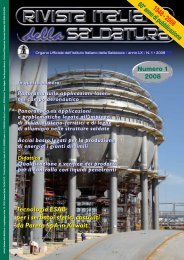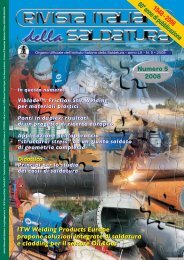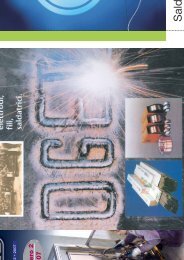Create successful ePaper yourself
Turn your PDF publications into a flip-book with our unique Google optimized e-Paper software.
International Institute of Welding<br />
Fracture analysis of<br />
strength undermatched<br />
welds of thin-walled<br />
aluminium structures<br />
using FITNET procedure (°)<br />
1. Introduction<br />
Driven by the demand for lighter and<br />
cost-effective airframes as well as by the<br />
close competition with the non-metallic<br />
composite materials, the design of<br />
metallic structures in the airframe fabrication<br />
has experienced revolutionary<br />
changes during the last decade. The well<br />
established joining technique by rivets is<br />
currently being replaced for some<br />
airframe applications by welding using<br />
novel welding technologies like laser<br />
beam welding (LBW) and friction stir<br />
welding (FSW). The adoption of these<br />
welding processes provides savings in<br />
structural weight and fabrication cost up<br />
to about 15% [1]. The most widely used<br />
metallic material in aircraft structures is<br />
aluminium and was deemed to be<br />
unweldable [2]. However, newly developed<br />
aluminium alloys with silicon (Si)<br />
and magnesium (Mg) as the main<br />
alloying elements facilitate the use of<br />
low heat input welding technologies to<br />
manufacture crack and porosity free<br />
welds with good mechanical properties<br />
compared to the properties of the<br />
conventional base material alloys.<br />
(°) Doc. IIW-1709-05 (ex-doc. X-1577-05) recommended<br />
for publication by Commission X<br />
“Structural performances of welded joints -<br />
Fracture avoidance”.<br />
* GKSS Research Center, Institute for Materials<br />
Research (Germany).<br />
Summary<br />
Stringer-to-skin joints in advanced<br />
airframes of some airplanes are already<br />
being produced using LBW with the use<br />
of 12% Si containing wire, whereas for<br />
the skin-to-skin joints, LBW and FSW<br />
techniques are currently under consideration<br />
in order to replace conventional<br />
E. Seib *<br />
M. Koçak *<br />
The paper presents a methodology for the residual strength prediction<br />
for the load carrying thin-walled components with highly strength undermatched<br />
welds containing cracks. The analysis is based on the strength<br />
Mismatch Option of the Fracture Module, being a part of the newly<br />
developed fitness-for service (FFS) procedure FITNET. The Mismatch<br />
Option of the FITNET Fracture Module allows for the account of weld<br />
features like the weld tensile properties and weld geometry in the fracture<br />
analysis of cracked welded components. The methodology described<br />
was verified with the generated experimental results within this investigation.<br />
The material used is an age-hardening aluminium alloy 6013 in<br />
T6 temper condition used in recent airframe components. The welds in<br />
the form of butt joints were produced using the CO 2 laser beam and friction<br />
stir welding processes. The deformation and fracture behaviour as<br />
well as the special features with respect to the FITNET FFS Procedure<br />
were analyzed. The results have shown that using the presented methodology<br />
along with newly proposed recommendations for the input data<br />
selection, conservative predictions of the maximum load carrying<br />
capacity of the large welded panels under tensile loading containing a<br />
long crack in the weld can be obtained.<br />
KEYWORDS: Aerospace; Aluminium alloys; Butt joints; Cracking;<br />
Defects; Deformation; Elongation; Fractures; Friction stir welding; Friction<br />
welding; Laser welding; Light metals; Mechanical properties; Mismatch;<br />
Plastic deformation; Photon beam welding; Radiation welding; Reference<br />
lists; Strength;Thermomechanically affected zone; Thin; Ultimate tensile<br />
strength;Weld zone;Yield strength.<br />
riveted lap joints. Current metallic<br />
airframes of airplanes are designed to<br />
satisfy the damage tolerance requirements<br />
in terms of fatigue and residual<br />
strength. The residual strength of a<br />
structure is defined as the remaining<br />
load carrying capacity in presence of one<br />
Riv. Ital. Saldatura - n. 1 - Gennaio / Febbraio <strong>2007</strong><br />
91





